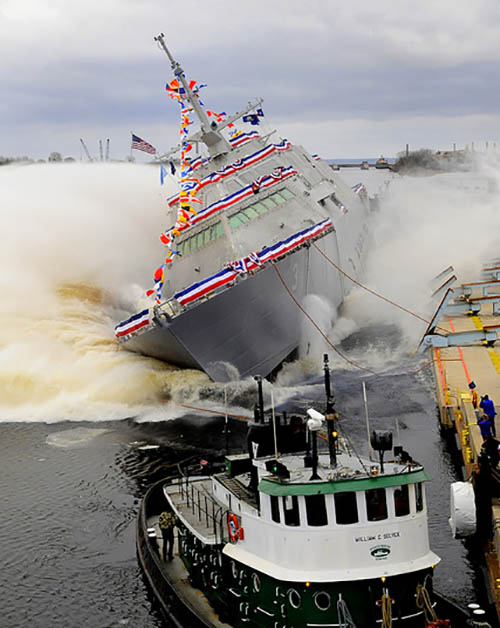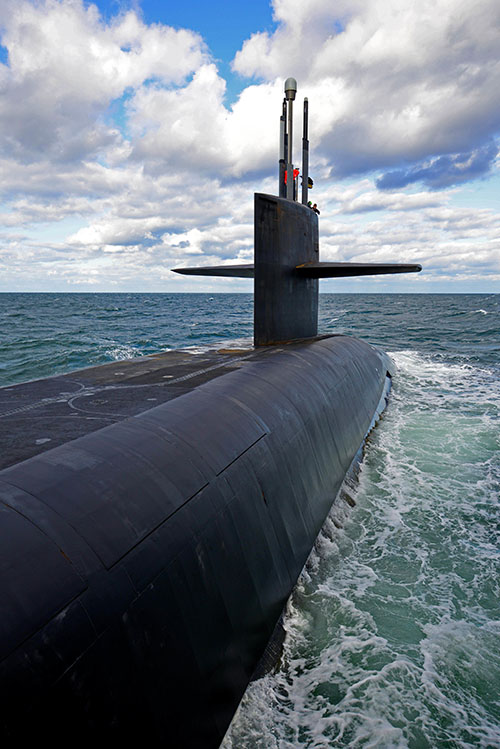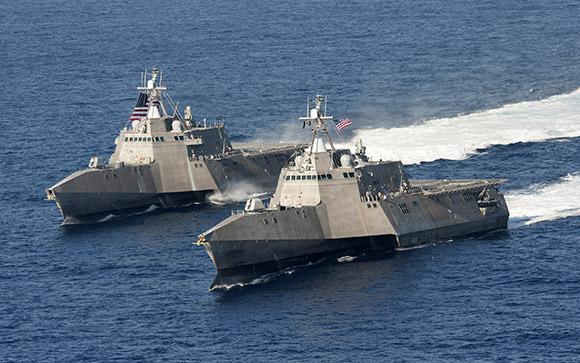The program for the acquisition of 52 Littoral Combat Ship heavily modified for the US NAVY, it could be deeply retouched to 40 units. In a memorandum delivered to Navy Secretary Ray Mabus signed by its Defense counterpart Ash Carter, the LCS Program converted to FF (where FF stands for frigate) could be reduced to 40 ships with a purchasing capacity 1-1-1- 1-2. Translated means one ship per year compared to the three planned (2017-2020) and two in the 2021. Eight less LCS less than the Navy's plans.
The LCS program is unique among the Navy classes. It is based on two completely different models: the class Freedom heavy 3300 tons produced by Lockheed Martin and the class Independence heavy 2.800 tons and built by Austal USA. The funds saved will be used to purchase other F / A-18, F-35, SM-6 missiles and to support the Virginia Payload Module. Class submarines Virginia (currently from block III) also implement two new large launch tubes, called "Virginia Payload Tubes", with a diameter of 87 inches capable of accommodating six Tomahawk each.
The Navy, which has already renounced two destroyers from the shipbuilding plan, considers the cuts on the LCS / FF absolutely inconceivable, considering also the time to build a carrier, higher than that necessary to make a fighter or a missile. Instead, the third and last should be saved from the cuts Zumwalt, Lyndon B. Johnson. The 4,4 billions of dollars needed to complete the last ship of the most powerful class on the planet should be immune to possible cuts. The line Zumwalt it will close with three snow on the 32 initially planned.

Carter grants the Pentagon another two billion dollars for the new class X, the futures boomers of the Navy that will have to replace the "Ohio" in service. The "Ohio" class submarines, the only ones to carry out patrols with nuclear weapons, will retire at the rate of one per year, starting from the 2029 when, that is, they will reach the end of their operational life of 42 years.
The Secretary of Defense also confirms the reinstatement of eleven cruisers, withdrawn from the service. They will all be updated and serve as escort ships for the aircraft carriers.
The United States Navy is now formed by 272 ships. In the 2020, according to construction plans, ships at sea will be 308.
Returning to the Littoral Combat Ship: six have been commissioned, 14 are under construction and another six are under contract.
The strategic launcher class "X"
The new SSBN-X will be as long as an original "Ohio" class (pictured below), but with eight less missile tubes than the "boomers" currently in service. The new boats will have to remain in service for 42 years. The American Navy, however, aims to build the largest submarine of its arsenal, with a displacement of 20 thousand tons: almost half of the Soviet "Typhoon" (about 45 thousand tons) and the same as the new Russian "Borey".
The SSBN-X, the result of sixty million hours of planning, will be armed with sixteen intercontinental missiles Trident II D5 LE (Life extension). The missiles, equipped with a new steering system, will remain in service until the 2042. The current operational service of the 14 "boomers" costs the US Navy 110 million dollars. The new boats will have to obligatorily have a cost of 4,9 billions of dollars to hull (almost double of an Ohio with a final cost of 2,9 billions of dollars).
Mission, to reduce costs far from easy. Suffice it to say that the leader of the 'X' will cost twelve billion dollars. The Navy has forecast an average expenditure of 5,36 billion by boat, which will go down, once production begins, to 4,9 billion hulled dollars. The total life cycle cost of all twelve new generation submarines is set at 347 billion dollars. Figures obviously denied by the Congressional Budget Office that in October of the 2013 has estimated in 87 billions of dollars only the costs of supply and in beyond 100 the billions of dollars for the total cost of development (among which the research and the development).
The first 'X' will have to be put into production within the 2019, with sea tests scheduled in the 2026 and the first deterrent service between the 2029 and the 2031. However these estimates are absolutely optimistic, considering that the US Navy has already announced that the entire program is two years late.

The twelve boats will guarantee the Navy's nuclear strategic deterrent service with ten 'X' submarines always operational and available at any time and two in maintenance. The new SSBN force will carry around 70 per cent of US nuclear warheads, consecrating the navy as a spearhead of the strategic triad and overshadowing the bombers and intercontinental ballistic missiles. The SSBN-X program could absorb one-third of the Navy's total budget for the 2020 / 2030, reducing the ability to purchase more ships and modernize the fleet.
Among the solutions proposed to reduce costs and avoid slowing down other similar programs, the purchase of an SSBN-X every two years, so as to try to reduce the impact of the program on the funds available for other ships or the creation of a fund specific, as happened for missile defense. In a report of the 2011, theManagement and Budget Office (OMB) suggested to the Navy to reduce the number of 'X' (from twelve to ten), bringing to twenty the launch tubes on each submarine. This would have saved at least seven billion dollars.
Another report from the 2013 by the Stimson Center suggested reducing the fleet of 'X' (from twelve to ten), but with the same launching capacity as sixteen submarine missiles. In this way, the Navy would have immediately saved a billion dollars and another ten in the next decade.
In another report of the 2013 Congressional Budget Office, the possibility of reducing the fleet of new submarines to eight boats is analyzed. The savings would amount to 15,7 billion dollars for the 2015-2023 and another forty in the following decade.
According to the studies carried out, a force of eight submarines would represent a powerful deterrent force and the ability to have an optimal number of missiles at sea for the First and Second Strike. A force of eight submarines would require a review of redundancy, now based on eight Ohio always in navigation.
(photo: US DoD)












